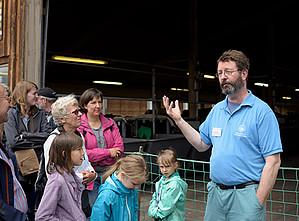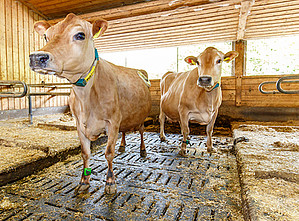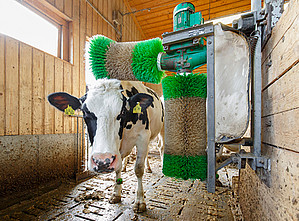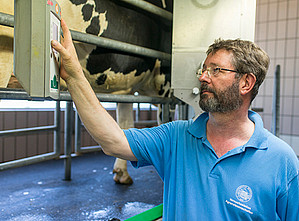 A Cow’s Life for Research - animal keeping at the Meiereihof research station
A Cow’s Life for Research - animal keeping at the Meiereihof research station
Raoul von Schmettow is one of 5 employees who supervise the animals at the Meiereihof research station. On the Open Day, he leads visitors around the stall close to the Hohenheim Palace. In the interview, the Experimental Technician answers the most questions visitors ask most frequently.
With a bucket of water and several packages of concentrated feed, the animal keeper enters the stall area where the most well-known experimental animals at the University of Hohenheim are kept: The fistulated cows. These are Jersey cows that have received an artificial opening into their rumen, the largest of the cows’ stomachs - a so-called rumen fistula.
The keeper has just entered the stall and the first cow is already trotting up, nudging him with her muzzle and standing still for her treatment. Every day one of the keepers checks to make sure the rumen fistula in her left side fits right, cleans it with warm water, and rubs a salve on the edges. During this treatment, the cow receives a reward of concentrated feed, then Cosima the cow is released and returns to her fellow cows.
Despite the peaceful scene: First-time visitors can feel a little uncomfortable when they see the rumen fistula, as the Experimental Technician Raoul von Schmettow knows. He also gives tours to visitors. That is why one of the most frequently asked questions from visitors is:
Why were holes put in the cow’s stomach?
Von Schmettow: Five of the animals here have these rumen fistulas. The fistula can be opened to take out specimens of the stomach contents. Here, the University of Hohenheim’s scientists look into the effects of various kinds of feed on the animals’ digestive systems, for example to find alternatives to imported soy or to decrease the production of methane gas, which is harmful to the climate. They can therefore contribute to more sustainable animal keeping with the type of feed used.
Hohenheim and other universities have been research in this way for decades. It used to be much more difficult to get samples of the stomach contents, however: The cow either had to be slaughtered or a tube had to be inserted into the stomach through the esophagus. That was very uncomfortable for the cows, they struggled and had to be tied up. With the rumen fistula, though, the animals hardly notice anything - as you can see, they stand there, very relaxed.
Don’t the fistulated cows suffer from the artificial hole into their stomachs?
Von Schmettow: No. The fistula is placed while the cows are under anesthesia. The edges are cleaned daily and a zinc salve is used so that no infections start. Around the plastic hold there is a foam cushion so that nothing rubs. The plastic hole can be moved and is not set in place, so it moves with the cow. There are also no signs of pain or stress in the fistulated cows.
It’s comparable to a colostomy for humans, for example after cancer. For people, a lot of the stress is psychological and comes from shame. Cows don’t feel this shame, for them a fistula is no problem.
The greatest stress for the animals is that they only get half of their regular food rations for two weeks after the operation. The reason is that the content of their rumen isn’t supposed to splash onto the new fistula, otherwise it could get infected. After two weeks of a diet, the cows can be fed normally again. But here you can also make a comparison to people: People who are operated often aren’t allowed to eat the same amount as usual before and after the operation.
While Cosima continues chewing, the experimental technician turns to the part of the stall across from her. Here is the largest group of cows: 36 German Holstein cows on 330 square meters of space. “That’s a bit more than the recommendation of 8 - 9 square meters per animal.”
The topic of animal well-being, reports von Schmettow, concerns a lot of his visitors. They want to know that the animals are doing well here another other places. “The idea of what an animal needs to be doing well is often strongly influenced by our own human needs. But you can’t always know what’s good for an animal just from that,” says von Schmettow. An example:
Wouldn’t cows be happier in the fields?
Von Schmettow: At the Meiereihof research station, the cows are usually in the stall because we wouldn’t be able to measure the amount they eat in the fields. That is why only the dry cows go out to the pastures. Those are cows that have a kind of “vacation” in the 8 weeks before they have their next calving and are no longer milked.
But cows don’t want to be outside all the time. Even if there are shady spots in the pastures - especially in summer the cows prefer to be inside, especially during the day. Here there is shade, fewer flies, with the sides open there is a cooling breeze, and once the temperature inside the stall reaches 20°C, two large fans on the ceiling move extra air into the stall. Cows like it cool. Only when the temperature drops below freezing in the winter are the side walls and stall doors closed.
So are the cows doing well here?
 Von Schmettow: Absolutely. That can even be seen in how the stalls are set up: In this stall, some inventions for animal well-being were invented that can be found in stalls around the world today. Examples are the soft rubber mats on the floor, or the automatic brushes that the cows can use whenever they want to care for their hide.
Von Schmettow: Absolutely. That can even be seen in how the stalls are set up: In this stall, some inventions for animal well-being were invented that can be found in stalls around the world today. Examples are the soft rubber mats on the floor, or the automatic brushes that the cows can use whenever they want to care for their hide.
We also like to show our milking parlor, where the cows are milked twice a day. We have an especially animal-friendly set-up here: With a special stimulation technique that is oriented strongly on a calf’s sucking, the cows are gently stimulated to give milk. With the very low milk vacuum, this is done very carefully for the udder.
You can also tell that the animals are doing well with the amount of milk they produce: When they’re in good health, the Hohenheim cows give an average of more than 11,000 liters of milk - that is almost 3,000 liters more than the German average. The milk has the highest quality and is sold to a dairy plant for further processing.
Can I see for myself that the animals are doing well here?
Von Schmettow: Yes, but only if someone from the stalls is with you. On the Open Day we offer tours in the stalls for interested visitors and explain exactly what is being researched here. You can also see the fistulated cows - but only from the outside.
The reason for this are the strict hygiene regulations: Besides staff members, only scientists and students can enter the stall and have to put on a full-body suit and plastic shoe covers so that no pathogens are brought into the stall with their clothes. Washing and disinfecting hands is mandatory.
The same applies for the staff: They have their stall clothes in the changing room and change each time they enter the stall. When milking or cleaning the fistulas, they wear plastic gloves.
Otherwise, though, does it look like any other stall?
Von Schmettow: Not entirely. There are various measurement instruments installed here for research. For example here, the feed troughs along the middle aisle: They are all on scales, and we have a gate with a chip recognition system. With the help of this feed trough, we can measure when and how much each cow eats. And we can make sure that it only eats a certain kind of feed. If a cow isn’t allowed to eat at a trough, then that gate stays closed.
the data are collected in the stall’s measurement stations, assigned to the right cow with the help of the chip number, and sent to the computer database. In the milking parlor - after the cow has been identified - the milker is provided information on the computer. The collar only contains one piece of information: The cow’s number.
In some experiments, some cows also wear a halter to measure their chewing and ruminating movements. These kinds of halters or similar techniques could be used by farmers in the future to better estimate the amount of feed being eaten in the pasture or to recognize illnesses at an early stage.
These kinds of halters or similar techniques could be used by farmers in the future to better estimate the amount of feed being eaten in the pasture or to recognize illnesses at an early stage.
In the milking parlor, the amount and flow of milk and its electrical conductivity can be measured, for example. Changes in the conductivity could mean that an udder infection is starting. Each animal also has a band with a step counter on its food that measures how much it moves. And the stall cleaning is done by an automated cleaning robot.
Some of the technical tools like measuring the amount of feed for individual animals are too expensive for normal dairy operations even if it would mean that could record precisely the feed intake of each animal. Other technologies are currently being introduced into the practice. For our scientists here at the university, the tools provide a great deal of valuable data.
Interview: Dorothee Barsch